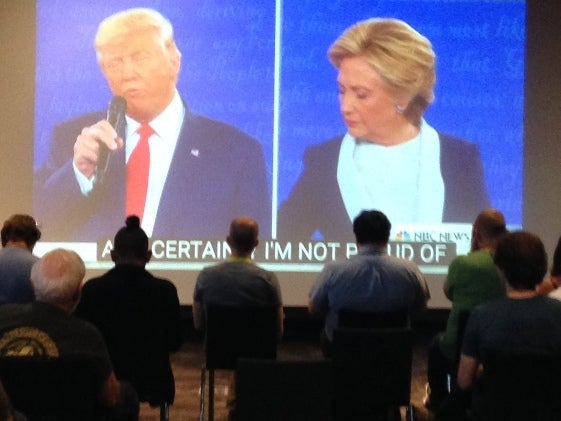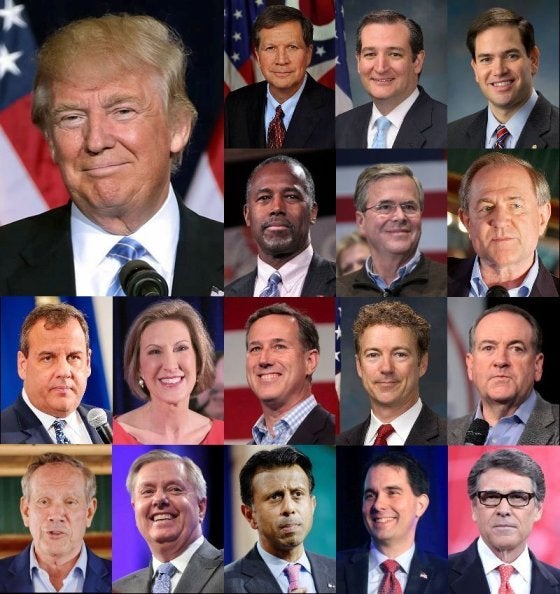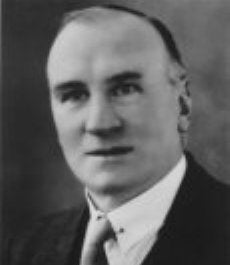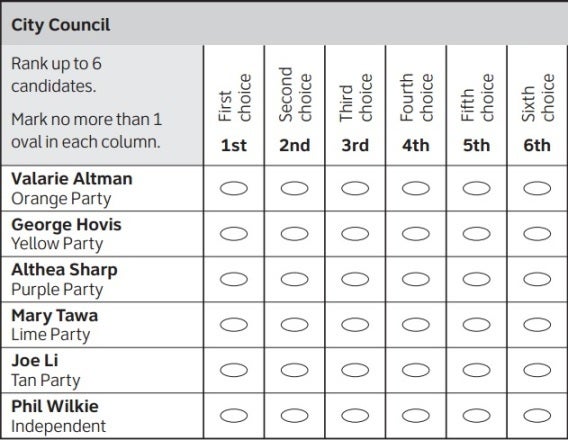
Voters watch the presidential debate in a public library.
The Disease
The 2016 primaries gave us the two least popular presidential candidates in history. One was undone by her penchant for secrecy and the vicissitudes of email. The other is now denounced by members of his own party for his dangerous irrationality, immaturity, incompetence, poor judgment, and lack of impulse control. President Trump’s extracurricular henchman, Steve Bannon, now threatens even solidly conservative Republican congressmen with expulsion via primary challenge, merely because they are not sufficiently loyal to the Dear Leader. The complete hijacking of the party now seems likely. Meanwhile America segregates into ever more polarized and extremist political tribes, each viewing the other as not merely misguided or mistaken, but evil. Something is wrong with this picture.
That something is our rotten primary system. It cannot be fixed. Like a cancer, it should be cut out altogether, and there is an elegant way to do it. Before I explain that cure, however, we need to examine the sickness.
The primary system is not the work of our Founding Fathers. It does not appear in the Constitution. It evolved in a haphazard way and has existed in roughly its current form only since 1992. There’s nothing sacred about it. To the contrary, it subverts democracy by raising the cost of campaigns, increasing the influence of moneyed interests, and creating disincentives and artificial barriers to entry for some of the most qualified of potential candidates. Worst of all, it polarizes the nation and thwarts majority rule by giving disproportionate power to a tiny fraction of voters at the most extreme fringes of the political spectrum.
The Six Percent Solution
We saw this most clearly in the last presidential campaign. When it began, Donald Trump’s supporters constituted only about 6 percent of the American electorate. As a fraction of Republican primary voters, the number was of course higher, about 25 to 35 percent. That’s still a minority, but in a field of 17 Republican contenders, it was enough to win early primaries, garner press attention, build momentum, and attract campaign contributions. Over subsequent primaries, the Republican field dwindled as Trump’s campaign grew from joke to juggernaut. Ultimately, however, his nomination had really been decided by only a tiny fraction of that initial 6 percent — the ones in states with early primaries. Late primary states with large populations, like California, had essentially no say in the process.

Divide and Conquer: It was our primary system and a huge field of contenders, not huge hands or genitals, that assured Donald Trump’s nomination.
Inevitably Exclusive
Other flaws in the primary system were evident on the Democratic side, notably the problem of barriers to entry. Hillary Clinton had long been seen as an inevitable favorite for the nomination, and with good reason. She had been a senator, a strong contender for the nomination in 2008, Secretary of State, and before all of that had studied the presidency up close and personal during Bill’s two terms. As Obama said at the convention, she really was one of the most qualified candidates ever to run for the office. Unlike Trump, she began her campaign as an unstoppable juggernaut. That aura doubtless discouraged other potential contenders for the nomination, leaving only the seemingly quixotic campaign of socialist Bernie Sanders to annoy her.
Vice president Biden, for example, had opted out, but I wonder how he felt about that decision on election day. Would he have been a candidate if the process had not required a year of grueling and expensive campaigning for primary after primary, if it had not demanded attacking a personal friend and being likewise attacked in return, and if he could somehow have known how weak Hillary would be in critical states? How many other potential candidates never even voiced their interest, let alone entered the race, because of that imposing juggernaut?

Non-candidate Joe Biden might have altered the outcome had he decided to run.
As it turned out, Bernie’s campaign was more than quixotic and revealed serious weaknesses in Hillary’s candidacy. His primary wins forced her to take more leftist positions, further weakening her prospects for the general election. Although Bernie stumped for her after the convention, he could never fully heal the rift in the party that his primary campaign had made.
The Cure
What’s needed is a voting method that chooses one winner out of a field of many candidates in a single election, and does so in a way that reliably reflects the will of the majority. The method most often touted for this is “instant runoff” voting, but that approach has a fatal flaw: it can easily fail to follow the will of the majority.

Australian astronomer and mathematician Joseph M. Baldwin, who devised the Baldwin variant of ranked choice voting in 1926.
The cure I’m advocating is called the Baldwin method. It has all of the advantages of instant runoff, but without its fatal flaw. As in instant runoff, the Baldwin method begins with ranked choice voting, in which voters rank the contenders in order from most to least preferred. This means that all voters participate in the winnowing process and have a large menu of candidates to select from, not just two. It means that Republicans get to vote on the Democratic contenders and vice versa, thus diminishing the influence of extremist minorities and favoring more centrist candidates from both parties. It means that voters whose first choice is a third-party candidate can cast that vote without fear of inadvertently helping a despised opposition candidate. The Baldwin variant of ranked choice voting better reflects the will of the majority, is resistant to manipulation through insincere voting, weakens the stranglehold of the two major parties, encourages greater civility among candidates, shortens the campaign season, and reduces costs for candidates and voters.

What a ballot looks like in any form of ranked choice voting. Unlike instant runoff, the Baldwin variant tolerates tied rankings and so would not need the warning about not marking more than one oval in a column.
And despite the fact that third party candidates have better chances under the Baldwin method, even the two major parties should love it if they give it some serious thought. Wouldn’t it have been nice for Republicans if, after Trump’s Access Hollywood tape and attacks on the gold star Khan parents, voters still had the option of voting for grown-ups like Jeb Bush or Marco Rubio? Wouldn’t it have been nice for Democrats if, after Hillary’s email scandal, voters still had the option of voting for Bernie Sanders, Joe Biden, or Barbara Boxer? Wouldn’t it be nice for congressional representatives if they could stop worrying about being “primaried” by extremists and focus instead on the needs of the broad majority of their constituents?
How Exactly Would This Work?
The standard (and defective) way of selecting the winner in ranked choice voting is to use instant runoff: pick the candidate who wins a majority of first-place votes, if there is one. If there isn’t, then the candidate with the least first-place votes is deleted and replaced on each ballot by the candidate ranked immediately below him. The process is repeated until a candidate in the top rank wins a majority.
By contrast, in the Baldwin method the least relevant candidate is rejected, not the one with the least first-place votes. The least relevant candidate is the one ranked lowest by all voters, on average. This process of elimination is repeated until only one candidate remains, and that candidate is mathematically guaranteed to be the one with broadest support among a majority of voters. For other important subtleties and details, including an elegant way of choosing the vice president, see my earlier article.
Here my goal is mainly to point out that the Baldwin method would fix the worst flaws in our electoral system, lead to more effective government, and prevent some of the most egregious sins that now dominate the news.

Why is this man smiling?
One of those sins is the meddling by Russian hackers in our 2016 election. Whether or not there was collusion by the Trump campaign, it is frightening that hackers could conceivably throw an election by influencing a few thousand votes in a few critical states. This points out yet another serious flaw, the Electoral College, which renders our electoral system dangerously fragile. By giving disproportionate power to small states and awarding electors in a winner-take-all way, the Electoral College not only thwarts majority rule, but also creates security holes for hackers by pinning the outcome on narrow votes in a few states. And although it is unlikely in practice, it should shock you to learn that our quirky Electoral College makes it technically possible for a candidate to win the presidency with less than 22 percent of the popular vote!
The most robust solution would be to scrap the Electoral College, along with the primaries, and use the Baldwin method to choose the president and vice president in a single general election. This should be our goal, but it will require a constitutional amendment, and that will take time.
Meanwhile, however, we can still scrap the primaries. Each party could hold a single, nationwide primary election using the Baldwin method to choose its slate of candidates for the general election. This would not be as robust as a single general election by Baldwin vote, but it would be a step in the right direction and a vast improvement over what we have now. It would lower the barriers that kept out Joe Biden, preclude the divide-and-conquer war of attrition that nominated Donald Trump, and eliminate the disproportionate influence of extremist voters in early primaries.

Out of Many, One: A fitting metaphor for the Baldwin variant of ranked choice voting.
Our Civic Duty
We should not be satisfied merely to lament our corrosive and divisive political tribalism. We should not be mollified by whatever exonerations or convictions fall out of the Mueller investigation. As we learn more about the Russian hacking, we should not be content merely to scold Vladimir Putin or slap new economic sanctions on the oligarchs. The problem isn’t in Russia. It’s here. We need a bipartisan commission on electoral reform. We need to draft a constitutional amendment. We need to clean up our own mess and make our electoral system truly representative and robust. And we should start by ditching the primaries.
For more on electoral reform and the Baldwin method, see my previous article. To get involved, share this article and contact your representatives.
John C. Wathey is an author and computational biologist whose research interests include protein folding, evolutionary algorithms, and the biological forces behind religion. Learn more at www.watheyresearch.com.
